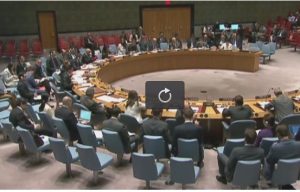.DISARMAMENT & SECURITY.
Meeting coverage from the United Nations
Queries Raised about Consensus, Clarity on State Responsibility, Victim Assistance
The Conference to negotiate a legally binding instrument to prohibit nuclear weapons considered a new version of the draft convention today [June 27], following the read-through of the earlier version last week, when delegations made proposals and suggestions.
Pushing ahead towards concluding with a final version by 7 July, Conference President Elayne Whyte Gómez (Costa Rica) presented a revised version of the draft instrument (document A/CONF.229/2017/CRP.1/REV.1), saying that in reviewing the draft “article by article”, her main focus had been on points of convergence..

Video from Press TV
Starting from the top, she said, the title had changed, referring to a “treaty”, the clear preference expressed by many delegations. However, the change in title would in no way affect the instrument’s legal status, she emphasized. Rather, it placed the draft convention on the same level as the many treaties negotiated over the decades with the aim of advancing progress towards the total elimination of nuclear weapons.
She went on to note that the draft preamble’s basic structure remained largely unchanged, although it did elaborate significantly on the humanitarian consequences of nuclear weapons and more accurately characterize the legal basis upon which the treaty would rest. New paragraphs had been added to recall essential principled efforts of the United Nations, reaffirm the inalienable right to the peaceful use of nuclear energy, and recognize the roles of women and men in the disarmament process. While the draft preamble was relatively long compared to other multilateral treaties in the nuclear field, she said, hopefully it provided a clear and precise narrative.
Concerning safeguards, she said consultations on the matter had revealed a number of complicated and technical issues, adding that she would continue to consult on the appropriate way to incorporate elements from the Annex into the first draft. The most significant innovation in the revised draft was in article 4, she added.
Following overwhelming interest from delegations, the draft now incorporated the so-called “join-then-destroy” pathway, she continued, underlining the contributions of South Africa, Austria, and Sweden. Article 4 now provided an option for States possessing nuclear weapons to join the treaty at an early date, subject to the obligation to eliminate its nuclear weapons arsenal. A considerable amount of flexibility had been built into that approach, because it must be fit to accommodate the widely varying nature of existing nuclear weapons programmes.
She said the role of the International Atomic Energy Agency (IAEA) had been carefully limited to verification of nuclear material in peaceful activities, in accordance with its current safeguards system. The so-called South Africa-plus pathway had also been retained, having been brought into line with the current safeguards system. The option to pursue additional protocols, including through negotiations with non-signatory States, had been retained as well. “Many delegations considered that it would be appropriate, prudent and wise to retain this option,” she stressed.
(Continued in the right column)
Can we abolish all nuclear weapons?
(Continued from the left column)
Article 9, on meetings of States parties, now elaborated specific items that could be considered in light of various provisions of the draft, she continued, adding that there was also a new provision to allow the convening of extraordinary meetings. The main change in the article on amendments was that it now provided for the consideration of proposed amendments at a conference dedicated for that purpose, in accordance with the normal parameters set forth in many treaties. Articles 4, 14 and 15 had been modified to allow the treaty to remain open for signature indefinitely, she said. And finally, the text of Article 19 had been modelled on the Arms Trade Treaty’s corresponding provision on relations with other agreements.
With the floor open for general comments, several delegates said they were awaiting instructions from their capitals. Iran’s representative emphasized the need for consensus on what exactly the treaty aimed to do. Proposing the deletion of Articles 2-4, he said such provisions were highly technical and complex, and requiring additional attention and time. Noting that several of his delegation’s suggestions for the draft preamble had been left out, he declared: “The revised text is far from a consensus text.”
Austria’s representative said a number of issues remained outstanding, particularly concerning Article 2 on declarations and Article 3 on safeguards. Article 14 on signatures could benefit from including the time and place where the treaty would be opened for signature, he added.
Ecuador’s representative referred to Article 7 on victim assistance, saying it was important to look at things from the victims’ point of view. That article must be strengthened to help alleviate the plight of victims and also to address environmental challenges, he said, stressing also that it should not be possible to withdraw from the treaty.
The representative of the Netherlands expressed disappointment that the revised text did not eliminate his concerns about the draft treaty’s effectiveness and its relationship with existing instruments. Its goal was to strengthen the Treaty on the Non-Proliferation of Nuclear Weapons regime, rather than to undermine it, he emphasized.
South Africa’s representative underlined the need to resume negotiations in “one common space” so as to develop the draft instrument. “It is not going to be the Secretariat that gives us a treaty,” she pointed out.
The observer for the State of Palestine said the revised version addressed a number of loopholes, despite worries relating to Article 2. There must be clarity on State responsibility, he stressed, insisting also that, given the nature of prohibition, there must not be any possibility of withdrawal.
Also speaking today were representatives of Malaysia, Argentina, Cuba, Ireland, Nigeria, Costa Rica, Mozambique, Liechtenstein, Antigua and Barbuda (on behalf of the Caribbean Community), Brazil, Switzerland, Thailand, Guatemala, Egypt, New Zealand, Sweden, Peru, Mexico, Chile and Algeria.
The Conference will reconvene in plenary session at 10 a.m. on Thursday, 29 June.